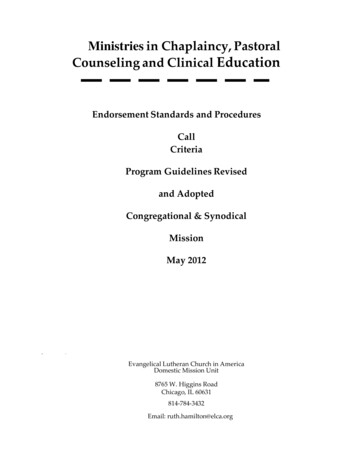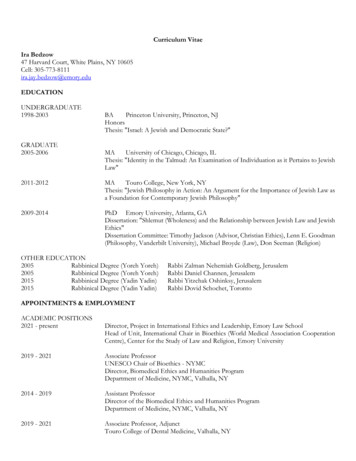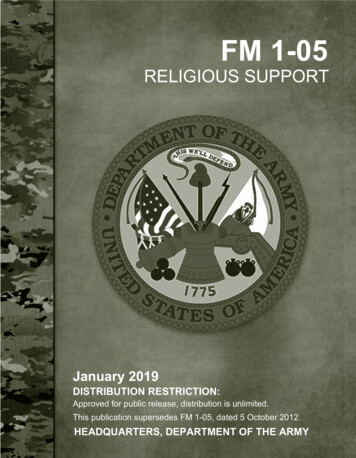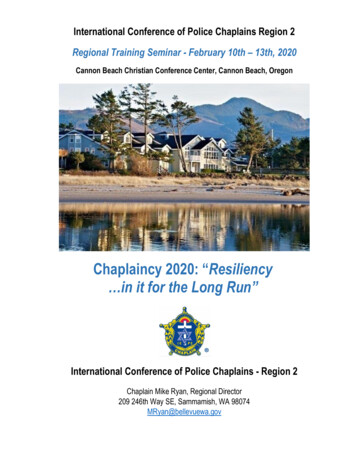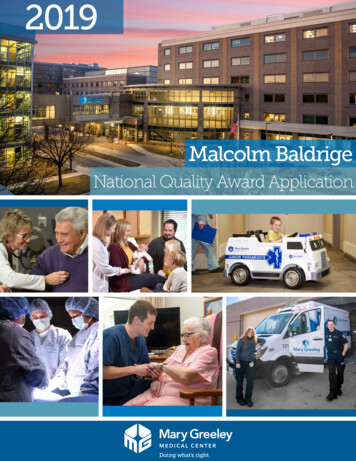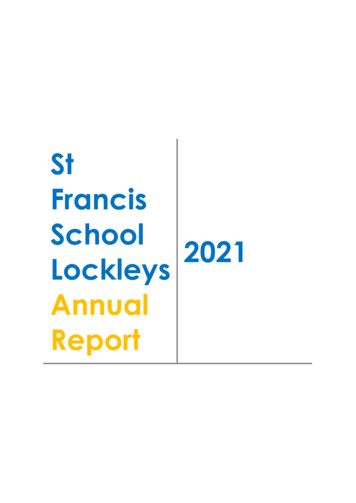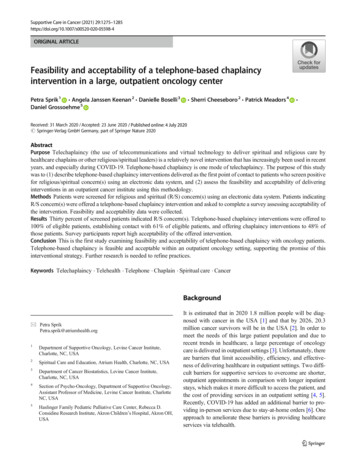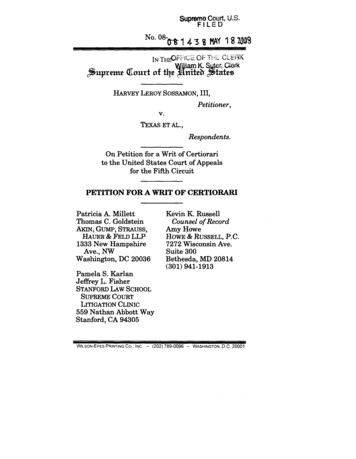
Transcription
Chaplaincy inEducationbe part of the story ‘The chaplain is there tolisten and care, to pray forand bless the school.’Year 7 studentNeil Wylie, Chaplain at Nailseaand Clevedon Schools.1Chaplaincy:spiritual andpastoral carefor all.
Toolkit for Chaplaincy in EducationThank you for your interest in chaplaincy in education.There are currently over 240 chaplains, serving in 124 chaplaincies across the Diocese of Bath and Wells.Schools and other organizations across Somerset, North Somerset and BANES are continuing to join thefast growing network.I hope that you find that this toolkit helps you to answer some of the questions I often hear: ‘How does chaplaincy work in a school or college?’ ‘Can community schools have chaplains?’ [brief answer, ‘Yes.’] ‘How can we develop a new chaplaincy?’ ‘How do I become a chaplain?’ ‘Can a lay person be a chaplain?’ [Yes, chaplains are lay or ordained and members of any Christiandenomination or church.]In order to establish a new chaplaincy the following will need to be agreed: the vision and job description; the funding; the training support and line management.I am very happy to come and meet with staff, students, governors or anyone else to help facilitatediscussions. If you have any additional questions or would like help setting up a chaplaincy in your college,school or Multi Academy Trust, please let me know.This toolkit has been developed and written within the Diocese of Bath and Wells and the ecumenicalchaplaincy network in Somerset. Those based beyond the borders of Somerset are also welcome to usethe toolkit and I hope that you will find it helpful.Revd Mike Haslam MAChaplaincy Development AdvisorDiocese of Bath and WellsE mail: mike.haslam@bathwells.anglican.orgPhone: 07530 677493 01749 685121@revmikehaslamWebsite: www.bathandwells.org.uk/chaplaincy2
Vision for Chaplaincy life in all its fullness There are many ways of articulating a vision for chaplaincy in education.Some of them are: Distinctively Christian and utterly inclusive, working with peopleof all faiths and cultures. Bringing ‘life in all its fullness’ to schools and colleges. Spiritual and pastoral care for all. The chaplain is there to listen and care, to pray for and bless theschool. The public face of God. Existentially literate, at ease with spirituality and with matters oflife and death. Sharing the life of the community; a member of the team, ratherthen a visitor.Patrick Weld, Chaplainat Danesfield andHaygrove Schools andHowever, what matters is your vision for chaplaincy in your college, school orGreat Wood Camp.MAT and how this fits within the wider vision for the school or MAT. Out of your The only ‘concerns’ fromvision will come the job description and the recruitment of your chaplain. From the schools that Patrickserves is that he isn’t fullthe vision will also come the resources, whether financial to pay a Chaplain, ortime in each of them!gifts of volunteer time or, as is most common, a combination of both.3Sarah Curl [centre], Chaplain to the Blue School inWells, with students at her commissioning.
Job Description: a mind mapSarah Curl [centre],commissioned as chaplainto The Blue School, Wells.4
Job Description: TextSchool or College ChaplainA chaplain is ‘the public face of God’ within an educational community. The role of the chaplain is key indeveloping the ethos and values of the school and offering pastoral and spiritual care to all. Chaplaincy is amissional and pioneering ministry. The number of hours a chaplain serves will inform the range of rolesand responsibilities. Some of these roles and responsibilities are outlined below, but not all things arepossible, especially within tight time constraints. It should also be remembered that the role is aboutbeing as much as it is about doing. Perhaps the most important part of a chaplain’s ministry is to be seenand to meet people and listen to them. Distinctive and Inclusive: Christian chaplains are clear and distinctive about what they believe.Following the example of Jesus, a chaplain meets and welcomes people where they are, accepting themunconditionally. A chaplain can prompt and respond to questions of faith, and there are many wonderfulopportunities for teaching, discussion and discipleship. The chaplain is there to be distinctive and inclusive,to share God’s presence by words and actions. Chaplains in church schools help to develop the Christianethos of the school and prepare for SIAMS. Developing a chaplaincy team: The chaplain will call, train and support a team of honoraryassociate chaplains from local churches. This team will fulfil a variety of the roles with some specialising[for instance in mentoring or leading a CU] and others having a more general role. All will be safelyrecruited and fully trained and supported in their roles. Listening: A chaplain goes into schools to listen. Assemblies, Bible Clubs, prayer meetings and worshipare important part of chaplaincy ministry, but the chaplain is there, first and foremost, to meet peoplewhere they are, to listen and to develop trusting relationships.5Jenny Jeffrey, SpiritualChaplainatBishopandHendersonCofE PrimarySchool, andyear 3childrentaking “thankyou cards” tolocalshopkeepersas part oftheir “acts ofkindness”towards thelocalcommunity.
Pastoral Care: Chaplains offer spiritual and pastoral care to all. This is offered, for instance, thoughlistening, restorative justice and mentoring for children, staff and families. In their spiritual and pastoralcare, chaplains work with the school pastoral staff and with external agencies. Prayer and Worship: The chaplain is there to pray for and with a school. In liaison with SLT,chaplains lead worship, collectively and corporately and enable prayer, worship and reflection thoughprojects such as prayer boxes or trees, Easter Crosses, Christmas Stars or other creative and reflectiveactivities. Celebrations, Charities and Crises: In liaison with SLT a chaplain will enable some of the greatcelebrations, faith festivals, anniversaries, jubilees and parties. Jesus was good at parties and a chaplaincan follow that example in a wonderful diversity of ways. A chaplain can be the charity coordinator,working with groups of students and enabling an outward focus. A chaplain can have a key support andleadership role amidst crises, whether caused by bereavement, redundancy, illness, major emergency orOfsted! In such contexts the chaplain can signpost to specialist support, listen to and support everyoneand lead or enable any appropriate services. Working with local churches: The chaplain will work with all of the local churches, reportingregularly and seeking partnerships for prayer and other forms of Christian ministry and especially enablinglinks between existing youth and children’s ministry projects and the schools. On the edge and in the centre: A chaplain is at the centre of the school with a direct link personwithin the senior leadership [often the Pastoral Deputy Head or equivalent]. A chaplain is also one stepremoved from the organisation that s/he serves; able to take a wider view and reflect back pastorally andprophetically. A chaplain has support from local churches. Clubs: Alongside Christian Clubs, the chaplain canalso be involved in a wide diversity of activities, sport,performing arts, home-work clubs, breakfast club, chessclub The list is endless and will depend on the skillsand interests of the chaplain and the time available.Chaplaincy at Haygrove SchoolBridgwater‘Patrick [the Chaplain at Haygrove] hascontributed so much to our communityThe possibilities for chaplaincy are endless [some areoutlined above] and the time is limited. Each college orschool is distinct, as is each chaplain, and there is a continualcycle of educational change. Therefore it is important for thechaplain to meet regularly with their SLT and Church leadersto reflect on the past term and discuss, discern and agree thepriorities for the term ahead.as a non-church school. I suspect thatThese two job descriptions, the mind-map and the text, arejust a beginning. We are happy to work with you to create ajob description for your particular context.and reflective element to our culture,there have been benefits for us, thatwe had perhaps not expected. Patrickhas earned huge respect in ourcommunity and has added a calmingwhich is noticeable on the days whenhe is with us.’Karen CanhamHead Teacher of Haygrove School.6
Gwen KearleyChaplain at St Michael’s Junior School, Twerton, BathMy chaplaincy role is about showing God’s love through my actions and the things that I do. My prayer isthat through the way I act, as well as the things I say, all people connected to the school will see me as anapproachable Christian presence and be able to choose to turn to God in their time of need.When I first took up the role, some parents hadn’t realised their children attend a Church School, andfound the idea of a chaplain a bit strange. I have spent the last couple of years building up relationshipsand I try to have an open door to anybody, at any time. At first, staff thought I was there only for thechildren, but increasingly they share things of their own lives. It’s great to be able to support the teachersin this way and share something of my own Christian faith. I see God at work in the school every day andmy role is to help children, parents and teachers see that for themselves.The children know me by my first name and see me as a friend more than a teacher-figure. We have aprayer space in the school and collective worship has become much more focused on Jesus, Christianvalues and sharing biblical stories.I also run a ‘Bible Is Fun’ club for children with a connection to the church. The children enjoy discussingdifferent issues and we each share our thoughts and look together at what the bible says. I am oftenhumbled by the way in which the children approach some of life’s big questions with such honesty; youcan see that God is at work.Being a school chaplain isn’t without its challenges, but it’s one of the most rewarding things I’ve done.7
Funding & PartnershipModels of Chaplaincy and FundingThere are many models of chaplaincy. Full-time, paid Part-time, paid. This can be anything from anextended lunchtime per week to four days aweek. A contract of 12 hours per week cansometimes be spread over three days. It alldepends on the chaplain and school or college. Secondment of youth or children’s workerfrom a local church for a set number of hours. This can work very well and can have moreimpact than a visiting youth worker.Honorary Chaplains who can either be the leadchaplain or a member of a chaplaincy team. Inboth scenarios they will still need to be safelyrecruited with role descriptions and will need tobe properly line-managed and resourced [therewill be expenses even if there isn’t a salary].Chaplains can be paid anything from 20,000 to 40,000 [full time equivalent] depending on their rolesand responsibilities. Chaplaincy posts are often part-time. A two day per week chaplain might cost 16 hours per week at an hourly rate of 12.53: 9,378.00 [full time equivalent 23,445]On costs Employers NI and Pension: 1,950.40Expenses 674.60Total 12,000Funding for Chaplaincy can come from a variety of sources Schools and MATs: We are under no illusions about how tightbudgets are. However, schools, colleges and indeed NHSTrusts that do fund chaplaincy don’t regret it. They also findthat it is a remarkably cost efficient leadership resource!Funding from Churches and individual Christians: Churchesand church members can be very generous and crowd-fundingmodels can be used.Funding from Trusts and Charities: Charities and trust fundscan fund chaplaincy. Local trusts and charities are helpful. 1 per childOne way of raising money is toask each school in a MAT andeach church which supportsthat school to give 1 for everychild in the school. This cancome from core funds or fromspecial fundraising.‘EmploymentThe chaplain will need to be safely recruited, employed and line managed.PartnershipHowever a chaplain is funded the creation of the role will almost certainly involve a partnership.This partnership can be nurtured by meeting three times a year to receive reports from the chaplain, seethe whole project, support the chaplain and discern the next steps. The partners who may be involved are: schools and MATs; churches; other funding bodies.8
How chaplaincy in education and localchurches can connect Prayer & WorshipLocal churches welcome schools for festival worship and prayfor the school or college. A prayer diary can be helpful.Collective worship is also an important cross-over between thelocal churches and the chaplain.Mentoring and ReadingIndividuals Christians can support the school and chaplainthrough offering mentoring and reading support for smallgroups or individuals.Christian GroupsHelp can be offered at Christian groups or with initiatives suchas ‘Open the Book’ or festival celebrations.FinanceLocal churches support chaplaincy financially [both though thecosts of salary and with funds for events or programmes].A ‘Church Trail’, from Taunton Academy; part of the RE curriculum.Local church leaders also came into the school to debate with studentson the subject: ‘Does the church in Taunton have a future?’Helena Power, Chaplain atRockwell Green School,Wellington.Rockwell Green School,Wellington, now has a newworship table in the hall.At a special assembly I gavethe children the cloths forthe different seasons of thechurch year, made fromtheir designs.The children were also verypleased to receive theliturgical teddy, with a setof vestments knitted bymembers of All Saints’church.9
Formation & TrainingThe ‘Exploring Chaplaincy’ courseThere are many opportunities to learn about chaplaincy, before you start or as you begin as a chaplain. Exploring Chaplaincy: This 8 session course [usually delivered either over 2 full days or 4 half days,explores:o the values and ethos of chaplaincy;o the biblical foundations of chaplaincy and prayer, worship and spirituality;o listening, pastoral care and mental health first aid;o resilience and reflective practice. Placements: These can range from half a day to one week, depending on availability from the schooland chaplain and the person exploring chaplaincy. Mentoring: All new chaplains are offered a mentor for their first year. If requested, a mentoringrelationship can continue. Review: The Chaplaincy Development Advisor offers chaplains and schools a review of chaplaincyministry. Chaplaincy Gatherings and Training days [5 per year]: These give space for prayer and fellowship,learning and reflective practice. A growing range of HE level courses.Making Chaplaincy workThings to be careful of Pray Clarity of vision and expectations withagreement from all the partners.Nurture the partnership with goodcommunications.Pick up on any issues early and address them. 10Changes in leaders within the partnership[chaplain, school or church].Remember, you’re not a mental health nurseor indeed a school counsellor.It’s important not to allow pastoral care[however important it is], to overwhelm therest of chaplaincy ministry.Managing differing expectations.
Discerning ImpactThere are many ways to discern the impact of chaplaincy. The qualitative [such as the stories and quoteswithin this toolkit] is just as important as the quantitative. Here are a few examples of using qualitativeand quantitative data to discern impact. Both of these models, taken from the Chaplaincy at The TauntonAcademy in 2016, use a sample of data taken at one point in the year and then rely on extrapolation. Thiswas repeated at the same point each year. This meant that it was an achievable rather than undulyonerous process.PS. Where are you based?PS. What are you called?A chaplain will need a phone and laptop,access to a desk and the school or college’sICT system. A chaplain will need access toa room for individual or small groupmeetings. A chaplain will also be welcomeacross the whole campus. A Sanctuary,Chaplaincy or Haven can be ideal as aspace for stillness and sanctuary and forrunning small groups. It also brings its ownchallenges, particularly staffing such aspace.A chaplain’s name and title needs to be agreed byall involved. In some communities the chaplain isthe chaplain and is called by his or her first name.In other places the chaplain is addressed as Mr /Ms / Revd . There are also communities whichare cautious about the title ‘chaplain’. In oneprimary school the chaplains became ‘FaithfulFriends’. There is no single answer, each contextwill be different, but it needs to be considered andagreed for it goes to the heart of the vision of therole.11
12
Chaplaincy in Education is only part of thepicture Other forms of Chaplaincy Chaplaincy in Village, Town and City Centres. From Trull to Taunton to Clevedon teams ofcommunity chaplains are good news to those who they serve. Chaplaincy to Local Government, charities, sport and leisure. Somerset County Council hasa chaplain as do the football clubs in Weston Super Mare and Bath. There are health and wellbeingchaplains in Wellington. Charities such as Genesis and Send a Cow [both in Bath] have chaplains. Chaplaincy to the Armed Forces and Police: Avon and Somerset Police have a chaplaincy team,which also co-ordinates chaplaincy for the Major Emergency Plan. There are chaplaincies at themilitary bases at NortonManor, Taunton andYeovilton. Chaplaincy to retail,industry andtransport: Anincreasingly number ofshops and shoppingcentres have chaplains.There are chaplains atHinkley Point NuclearPower Station, on therailways and at AvonmouthPort [pictured]. Healthcare Chaplaincy:There are chaplains in all ofthe acute and communityhospitals, in the mentalhealth units and thehospices. Chaplaincy to GPsurgeries is developing.13
ConclusionsChaplaincy in Education is transformative and: offers spiritual and pastoral care to everyone and shares thelife of the community; is distinctively Christian and utterly inclusive and works withpeople of all faiths and cultures; is ‘the public face of God’ for the community; ‘is there to listen and care, to pray for and bless theschool/college.’Chaplains can be lay or ordained and from any Christian church. Withthe support of local churches and the diocese, anyone can be calledand trained to be a chaplain.‘We ddn’t realise howmuch value the Chaplaingave until he wasn’tthere.Jayne Davis, Vice Principle ofBath City College[Bath City College are in theprocess of appointing a newChaplain]If you have any questionsor would like to meet to discuss and explore Chaplaincythen please contact me.Revd Mike Haslam MAChaplaincy Development Advisormike.haslam@bathwells.anglican.orgPhone: 07530 677493 01749 685121Twitter: -mission/mission/chaplaincy/14The Haven. The base for thechaplains at Selwood Academy.
PrayerAlmighty God,whose service is perfect freedom,as we hear your callto serve your people through chaplaincyin our schools and colleges,lead us by your Spirit,transform us into the likeness of Christ,and help us to live in your liberty.Enfold our school and college communities in your loveand draw us closer together.For goodness is stronger than evil,Love is stronger than hate,Light is stronger than darkness,Life is stronger than death,Victory is ours through Jesus Christ who loves us.Amen.Jesus said, ‘I have come to give you lifein all its fullness.’ John 10.1015
10 Steps to Setting up a School Chaplaincy1. Understand the context: meet with parish and school leadership to audit what links andrelationships may already exist between church and school.2. Establish the capacity: who are the people in the parish, other churches locally or in the school whohave a calling and capacity to offer time, money, energy or all three?3. Put it on the agenda: agenda item at PCC, Deanery Synod, Chapter meeting or Churches Together,whichever of the above seem most appropriate and harness most energy.4. Form a Working Party: who will make an effective, easily mobilised and dynamic group for carryingthe vision of chaplaincy forward? You might wish to involve the Chaplaincy Adviser at this stage, orbefore.5. Approach the school: having identified links that already exist, and having considered realisticcapacity, approach the school via your link, to ask “how can we best serve you?”6. Identify a chaplain: assuming the school is positive about your offer and interested in chaplaincy,consider whether someone already exists in the community who could adopt the role of Chaplain.This might be an already licensed minister, a youth worker, a retired teacher etc. If no such personis found, then this becomes a larger question about funding.7. Build a Team: given that a full time, fully paid Chaplain’s post is unlikely to emerge quickly, who elsecould support the Chaplain/Chaplaincy and increase capacity and effectiveness?8. Draw up a Job Description: work with the school, churches and individual to create a realistic jobdescription for a Chaplain or Chaplaincy Lead.9. Train the Chaplain: working with the Diocese, embark on a course of continuing training to raiseawareness of issues and build up appropriate skills for a successful and impactful chaplaincy10. Commission the Chaplain: The Chaplain should be commissioned, if possible, in the context of theschool and with the presence and support of local churches.16
the vision and job description; the funding; the training support and line management. I am very happy to come and meet with staff, students, governors or anyone else to help facilitate discussions. If you have any additional questions or would like help setting up a chaplaincy in your college,
